Results 10,071 to 10,080 of 12091
Thread: Anandtech News
-
11-21-19, 09:52 AM #10071
Anandtech: AMD Clarifies "Best Cores" vs "Preferred Cores" Discrepancies For Ryzen CP
Over the last several weeks there’s been increasing discussions in the AMD enthusiast community about how the company’s new Ryzen 3000 processors interact with Windows, and in particular on how the new CPUs’ boost behaviour behaves in relation to a discrepancy between what tools such as Ryzen Master showcase as the best CPU cores, and what operating systems such as Windows interpret as being the best CPU cores. Today AMD is officially commenting on the situation and why it arises, whilst also describing what they’re doing to remedy the discrepancies in the data.
More...
-
11-21-19, 06:00 PM #10072
Anandtech: Philips Unveils Brilliance 439P9H SuperWide 32:10 Curved Prosumer Monitor
Philips this week announced a new ultra-wide display aimed at prosumers. The curved Brilliance 439P9H brings together a large 32:10 aspect ratio panel with USB Type-C docking capabilities, an integrated KVM switch, a wide color gamut, factory calibration, and more. And while the monitor is not aimed at color-critical workloads, many users who need accurate colors may actually consider it.
The Philips Brilliance 439P9H uses a curved VA panel featuring a 1.8-meter radius curvature, and a 3840x1200 resolution. Other characteristics of the LCD include a max brightness of 450 nits, a 3000:1 contrast ratio, 178º/178º vertical/horizontal viewing angles, a 4 ms GtG contrast ratio, and up to a 100 Hz refresh rate. The display can reproduce 123% of the sRGB, 95% of the DCI-P3, 91% of the AdobeRGB, and 105% of the NTSC color spaces. Furthermore, it comes factory calibrated to a Delta
-
11-21-19, 06:00 PM #10073
Anandtech: Oculus Link Software Available: Oculus Quest Can Now Tether to PCs
Oculus VR this week started to distribute its Oculus Link software, enabling owners of the standalone Oculus Quest VR headsets to connect them to gaming PCs and play games originally developed with the Rift and Rift S in mind. For now, VR gamers will have to use a quality third-party USB 3.2 Gen 1 Type-C cable, but later on the company promises to release its own long cable.
From now, a beta version of the Oculus Link application for Oculus Quest is available from Oculus VR as a part of the Gear VR Build 11.0 software update. To connect the Oculus Quest to a PC, one needs a high-quality USB 3.2 Gen 1 Type-C cable, though since most USB 3.x cables are around 1.5 meters long, you'll want to track down a longer specialty cable. Otherwise, Oculus promises to release a five-meter long USB-C cable in the near future to provide more freedom. Meanwhile, PC users will want to pay particular note to the fact that only NVIDIA cards are supported with the Link software at this time; Oculus will be adding AMD support at a later date.
The Oculus Quest is a standalone VR HMD featuring a display of a 3200×1440 (1600×1440 per eye) and powered by the Qualcomm Snapdragon 835 application processor. The device comes with Touch controllers bundled with the original Rift, yet relies on its inside-out 6-degree-of-freedom (6DoF) positional and controller tracking that does not require any external sensors.
In theory, making Oculus Rift games available to owners of the Oculus Quest and a compliant PC is a big deal for Oculus VR as it expands total available market of VR PC games and therefore strengthens the entire platform. This clearly does not hurt in the light of the fact that the Half-Life: Alyx game is coming and many fans of the series will have to use a VR headset to enjoy it. Meanwhile, it remains to be seen how good the actual PC gaming experience offered by the Oculus Quest will be provided that it has a higher-resolution display (when compared to both Rift and Rift S) and uses a different tracking system.
Related Reading:
- Oculus Link Software: Connecting Oculus Quest to a Gaming PC
- Oculus Quest Announced: A 6DoF Standalone VR Headset
- Oculus Rift S VR Headset: An Upgraded Virtual Reality Experience
- VirtualLink USB-C Alt Mode Announced: Standardized Connector for VR Headsets
- Oculus Announces Oculus Go: Untethered VR For $199 USD
- Oculus Announces Six Week Sale of $399 Rift + Touch Bundle
Source: Oculus VR
More...
-
11-22-19, 10:29 AM #10074
Anandtech: GIGABYTE Aorus RTX 2080 Ti Gaming Box: Liquid-Cooled TB3 eGFX Box
GIGABYTE has introduced a new Thunderbolt 3 eGFX box that promises to be one of the most powerful eGPUs on the market. The Aorus RTX 2080 Ti Gaming Box packs NVIDIA’s GeForce RTX 2080 Ti graphics card equipped with a closed-loop WaterForce liquid cooling system that is designed to maximize its overclocking potential.
GIGABYTE’s Aorus RTX 2080 Ti Gaming Box carries fairly typical GeForce RTX 2080 Ti video card, with the clocks running at NVIDIA's reference speeds. Instead, focusing on end-user overclocking, the Aorus RTX 2080 Ti Gaming Box uses a custom closed-loop WaterForce liquid cooling system that the graphics processor, VRM, and RAM. I will not hazard a guess about overclocking potential of a graphics board in a small box with a liquid cooler, but it's certainly a dense cooling operation.
Just like regular GeForce RTX 2080 Ti cards, the Gaming Box has three DisplayPort 1.4 outputs, one HDMI 2.0b port, and one VirtualLink (USB-C) output that provide compatibility with all modern desktops and the latest VR headsets. Further, the Gaming Box has a triple-port USB 3.0 hub and an GbE port. As an added bonus, the eGFX solution has, as does practically everything else these days, addressable RGB lighting.
Measuring 300×173×140 mm, the Aorus RTX 2080 Ti Gaming Box resembles a Mini-ITX PC, though very few of the latter can pack so much graphics and compute performance into this small of a space. Taking full advantage of the size and intending for their Gaming Box to be more than just a home docking solution, GIGABYTE ships the 3.8-kilogram eGPU with a special carry on bag.
For a unique graphics solution that will highly likely be a low volume product, the Aorus RTX 2080 Ti Gaming Box seems to be priced rather reasonably. GIGABYTE’s MSRP of the device is $1,499, which is consistent or slightly better than BYO eGFX solutions after factoring in the 2080 Ti and the liquid cooling system.
Related Reading:
- PowerColor's External Behemoth: The 750 Watt TBX-750FA eGFX Box, With 100 W Power Delivery
- Exploring Thunderbolt 3 eGFX Performance, Feat. PowerColor's Gaming Station & Radeon RX Vega 56 Nano
- ZOTAC Unveils AMP Box and AMP Box Mini eGFX TB3 Chassis
- GALAX, KFA2 Launch SNPR External GPU Enclosure with GTX 1060 6 GB
Source: GIGABYTE
More...
-
11-22-19, 11:57 AM #10075
Anandtech: Colorful Unveils CVN X570M Gaming Pro Micro-ATX Motherboard
With all the attention turned to AMD and its platforms for the impending Ryzen Threadripper 3000 processor launch, Colorful has announced its latest micro-ATX motherboard for the X570 chipset, the Colorful CVN X570M motherboard. Building on its CVN X570 Gaming Pro V14 ATX model, it uses a similar feature set, but with a smaller footprint with its micro-ATX frame. Its design revolves around the CVN class of aircraft carriers, looking to fly gamers into the battle that use AMD's Ryzen 3000 processors.
While Colorful hasn't officially launched a detailed list of specifications, we do know that the CVN X570M Gaming Pro has two full-length PCIe 4.0 slots which are likely to run at x16 and x16+x4 or x16+x8, with two PCIe 4.0 x4 M.2 slots. The X570 chipset heatsink includes active cooling, while the power delivery is cooled by a pair of two-tone silver heatsinks, with one doubling up as the board's rear panel cover. Providing power to the CPU is a single 8-pin 12 V ATX power input, while a standard 24-pin ATX 12 V ATX input delivers power to the rest of the board. The Colorful CVN X570M Gaming Pro has six SATA ports which support RAID 0, 1, and 10 arrays, while the board also includes four memory slots with support for DDR4 memory.
On the rear panel is one USB 3.1 G2 Type-C, a single USB 3.1 G2 Type-A, four USB 3.1 G1 Type-A, and two USB 2.0 ports. While it's hard to determine the full USB specifications, this is likely the configuration on the Colorful CVN X570M Gaming Pro. Taking care of the six 3.5 mm audio jack is a Realtek audio codec, likely ALC892 judging by the lack of an S/PDIF optical output, while an HDMI and DisplayPort pair of video outputs allow this model to be used with compatible Ryzen APUs. Also featured is a single PS/2 combo port, while the single Ethernet port is powered by a Realtek RTL8111H Gigabit controller.
At the moment, there is no information about the price or availability for the Colorful CVN X570M Gaming Pro, but it is expected to sit towards the bottom of the X570 product stack in terms of pricing. It's unique in its militaristic CVN aircraft design, but if availability is similar to the Colorful CVN X570 Gaming Pro V14, it might not filter into retail channels in the US and EU as quickly as anticipated, if at all.
Related Reading- AMD + ITX + TB3? It's the ASRock X570 Phantom Gaming-ITX/TB3 Motherboard Review
- In The Lab: ASRock X570 Aqua Motherboard Preview
- The GIGABYTE X570 Aorus Xtreme Motherboard Review: Fanless AM4
- Best Motherboards Q3 2019
- The MSI MEG X570 Godlike Motherboard Review: Thor's Flagship
More...
-
11-22-19, 02:27 PM #10076
Anandtech: New NVIDIA GPU Variant Found at Supercomputing 2019: Tesla V100S
NVIDIA announced a number of things at Supercomputing, such as CUDA on Arm. Despite the show being the major hub event for high-performance computing/supercomputers, it isn’t often the location where NVIDIA launches a GPU. Nonetheless we saw a new model of NVIDIA’s high performance V100 at multiple booths at Supercomputing.
More...
-
11-22-19, 02:27 PM #10077
Anandtech: Biostar Launches M700 SSDs: Entry-Level PCIe SSDs
After entering the SSD market a couple of years ago, Biostar has been playing things cautiously, only offering low-cost SATA drives. But as the prices of PCIe SSD controllers and 3D TLC NAND memory continue to drop, it gets possible to build cheap PCIe drives to address the entry-level market with better products. To that end, this week Biostar introduced its M700-series SSDs, its first set of PCIe 3.0 x4 drives.
Biostar’s M700 SSDs are based on Silicon Motion’s proven DRAM-less SM2263XT controller, whose value proposition today may sound like a ‘PCIe drive at a price of a SATA SSD’. Targeting entry-level builds, M700 SSDs come with 256 GB or 512 GB of usable 3D TLC NAND flash memory. The drives fully support contemporary SSD feature set like the end-to-end data protection, NVMe 1.3a protocol, L1.2 low power mode, AES256 encryption, and come in an M.2-2280 form-factor without a heat spreader to maintain compatibility with laptops.
As far as performance is concerned, Biostar says that the SSDs are capable of up to 2000 MB/s sequential read speed as well as up to 1600 MB/s sequential write speed (in case of the 512 GB SKU), which is in line with capabilities of the controller and way higher than any SATA SSD. As for random performance numbers, Biostar isn't listing anything in the official spec sheet, but based on other SM2263XT drives, we're likely looking at something around ~240K/260K random read/write IOPS here.
Biostar will start selling its M700 256 GB and M700 512 GB SSDs in the near future. The company does not reveal official MSRPs, but expect these to hit the market at a price similar to other entry-level SSDs.General Specifications of Biostar's M700 SSDs Capacity 256 GB 512 GB Model Number M700-256GB M700-512GB Controller Silicon Motion SM2263XT NAND Flash 3D TLC NAND Form-Factor, Interface M.2-2280, PCIe 3.0 x4, NVMe 1.3a Sequential Read 1850 MB/s 2000 MB/s Sequential Write 950 MB/s 1600 MB/s Random Read IOPS ~200K IOPS ~240K IOPS Random Write IOPS ~260K IOPS ~260K IOPS Pseudo-SLC Caching Supported DRAM Buffer No TCG Opal Encryption No Power Management L1.2 power mode support for ultra-low power consumption
Idle: 0.2 W
Active: 2 WWarranty ? years MTBF 1,500,000 hours (?) TBW ? ? Additional Information Link Link Launch Price ? ?
Related Reading:
- Biostar Unveils Racing X570GTA Motherboard
- Team Group Unveils MP33 SSDs: Entry-Level PCIe Drives
- Mushkin’s Helix-L SSDs Available: Pushing the Price of 3D TLC
- Klevv Adds Kolors: RGB-Lit Enthusiast-Class Cras DIMMs & SSD Incoming
Source: Biostar
More...
-
11-25-19, 05:42 AM #10078
Anandtech: Intel Launches Cascade Lake-X Processors: 18-core Review Later Today
Earlier in October, Intel announced that it would be launching its next generation high-end desktop processors in November. That day has come, and Intel expects its hardware to be available worldwide starting today. The new processors are effectively speed bumps of the previous generation Skylake-X Refresh hardware, but with a cunning twist: pricing has been substantially cut in order to compete with other hardware available in the market. Intel’s 18-core processor now has OEM pricing of $979, almost half of the $1900+ value it had in the previous generation. Reviews will be going out today too, but we’re withholding ours for a few hours, for one very special reason.
Today Intel is formally launching four new CPUs, from 18-core down to 10-core, all built on its HCC Xeon silicon but aimed at the high-end desktop market. These CPUs are very much like the previous generation, except for some extra frequency, a handful of extra PCIe lanes, better memory support, some hardware security fixes, and the slashed pricing.
These new CPUs now support up to 256 GB of DDR4-2933 (up from 128 GB of DDR4-2666), and 48 PCIe 3.0 lanes (up from 44). The base frequency of the halo Core i9-10980XE part stays the same, but the turbo values go up +100 MHz as part of a more aggressive binning strategy.Intel Cascade Lake-X AnandTech Cores
ThreadsBase All
CoreTB2 TB3 TDP Price
(1ku)Core i9-10980XE 18C / 36T 3.0 3.8 4.6 4.8 165 W $979 Core i9-10940X 14C / 28T 3.3 4.1 4.6 4.8 165 W $784 Core i9-10920X 12C / 24T 3.5 4.3 4.6 4.8 165 W $689 Core i9-10900X 10C / 20T 3.7 4.3 4.5 4.7 165 W $590 Skylake-X (previous generation) Core i9-9980XE 18C / 36T 3.0 4.5 4.7 165 W $1979 Core i9-9940X 14C / 28C 3.3 4.5 165 W $1387 Core i9-9920X 12C / 24T 3.5 4.5 165 W $1189 Core i9-9900X 10C / 20T 3.5 4.5 165 W $989
For security fixes, Intel has now fixed in hardware Spectre/Meltdown variants 2, 3, 3a, 4, and L1TF. This is the same level of hardware protection as the Cascade Lake Xeon Scalable family, now available in the high-end desktop. This hardware does not contain fixes for the recent disclosure of the Zombieload v2 exploit, it should be noted, so that will be patched in firmware in due course.
Intel is set to push these new processors on several fronts, one of which will be its AVX-512 VNNI support, along with DL Boost support for AI researchers looking to accelerate their CPU codes. Another angle for Intel will be that they offer high-performance hardware with more I/O than AMD in that sub-$1000 range. AMD is also launching its new high-end desktop processors later today, but those start at $1399 as was previously announced, and as a result Intel has that HEDT market under $1000. AMD does have a 16-core processor at $749, with 24 lanes of PCIe 4.0, which means that for users that are not IO limited, there is a lot of choice in that sub-$1000 category.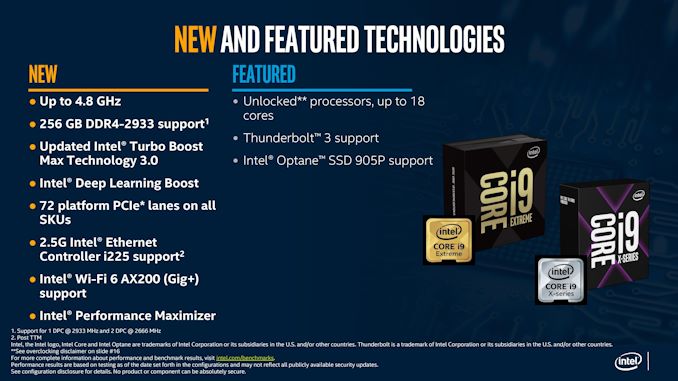
'2.5G Ethernet' and 'Wi-Fi 6' support are dependent on additional system controllers;
For some reason despite previous systems also supporting these, Intel felt the need to add them to this slide
Reviews for the new Cascade Lake-X processors are set to go live today. We are delaying ours by a few hours, until the embargo for AMD’s new Threadripper processors also lifts. Not only is it odd to have both companies launch their HEDT products on the same day, but originally they were set to launch at the same time – Intel since moved their launch forward a few hours, but we’re going to wait until AMD’s embargo has also been lifted so we can provide graphs with all the CPUs together in their respective reviews.
Please keep this page bookmarked, as we will update here later today with our full review of the Core i9-10980XE.
More...
-
11-25-19, 11:14 AM #10079
Anandtech: Intel and MediaTek Announce Partnership To Bring 5G Modems to PCs
Today Intel has announced they’ve entered a partnership with MediaTek with the goal of “development, certification and support of 5G modem solutions” for next generation PC platforms. The announcement comes 5 months after the announcement that Intel is selling off its own modem and division to Apple for $1B.
The partnership with MediaTek clears up Intel’s plans for the future of connectivity on PC platforms, and how the company is planning to go forward with supporting cellular connectivity in the next generations of devices.
“5G is poised to unleash a new level of computing and connectivity that will transform the way we interact with the world. This partnership with MediaTek brings together industry leaders with deep engineering, system integration and connectivity expertise to deliver 5G experiences on the next generation of the world’s best PCs.”What is surprising about the announcement isn’t that Intel is partnering with an external supplier, but rather that MediaTek has managed to get the design win, rather than the usual suspects such as Qualcomm or Samsung. Under the deal, Intel is said to “define” the 5G solution specification that will be developed and delivered by MediaTek. The wording of the announcement sounds more akin to a semi-custom deal, rather than just MediaTek providing their own product design or part which was on their roadmap. Depending on the specifications and how it diverges from MediaTek’s existing portfolio, the company’s willingness to enter such a deal with Intel might be a reason they won the contract, as maybe Qualcomm and Samsung wouldn’t be that open to such a collaboration.
-- Gregory Bryant, Intel executive vice president and general manager of the Client Computing
While MediaTek will be wholly responsible for the design and manufacturing of the modem, Intel will be working on the platform-side integration as well as OS host driver development. Fibocom will also be cooperating with Intel and MediaTek to develop M.2 modules with the new chipset and integrating them with Intel’s client platforms.
The first products of the partnership are said to be targeting availability in early 2021.
Related News:- Intel Exits 5G Smartphone Modem Market; Other Client Modem Businesses to Be Reviewed
- Apple to Buy Bulk of Intel’s Smartphone Modem Business For $1 Billion
- MediaTek Announces 7nm 5G With Cortex-A77 CPU, Mali-G77 GPU Coming
More...
-
11-25-19, 11:14 AM #10080
Anandtech: It’s a Cascade of 14nm CPUs: AnandTech’s Intel Core i9-10980XE Review
The most profitable process node in the history of Intel has been its 14nm process. Since 2014, the company has been pumping out CPUs built on a variety of configurations of its 14nm – slowly optimizing for power and frequency. We used to call these variants 14+ and 14++, but as the next process node isn’t yet ready, rather than draw attention to a soon-to-be 6-year old process, Intel just calls it all ‘14nm class’. The latest launch on 14nm is Intel’s new Cascade Lake-X processors: high-end desktop hardware that gives a slight frequency improvement over Skylake-X from 2017 but it also has the first round of hardware mitigations. Today we’re testing the best CPU of the new list, the Core i9-10980XE.
More...
Thread Information
Users Browsing this Thread
There are currently 25 users browsing this thread. (0 members and 25 guests)





 Quote
Quote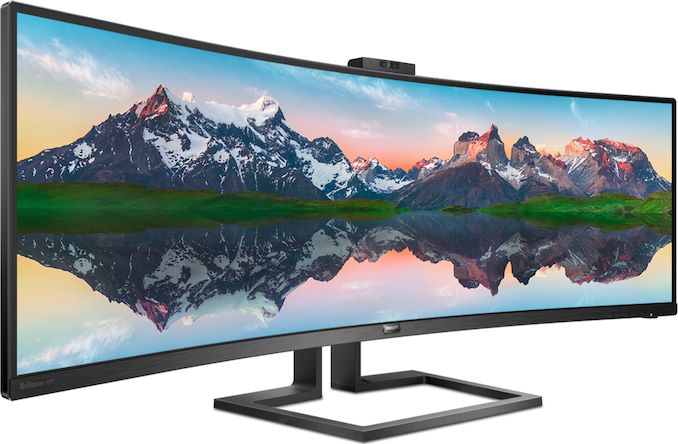

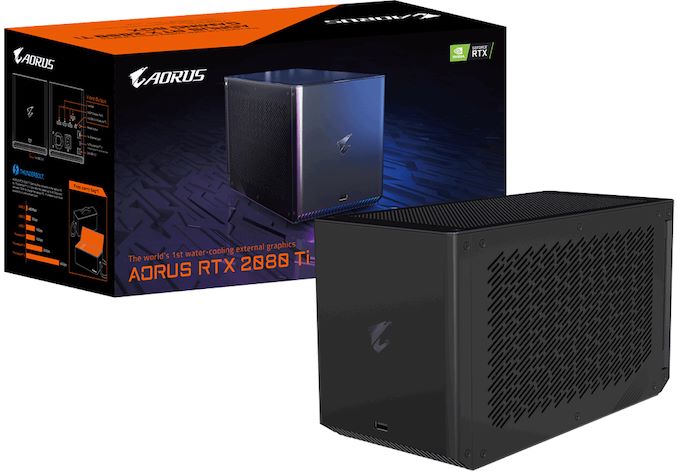
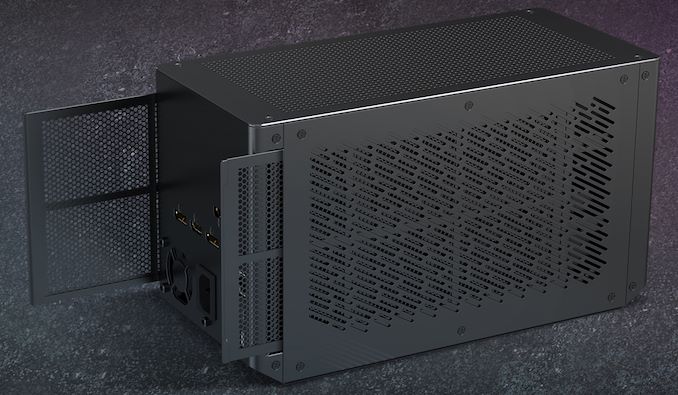
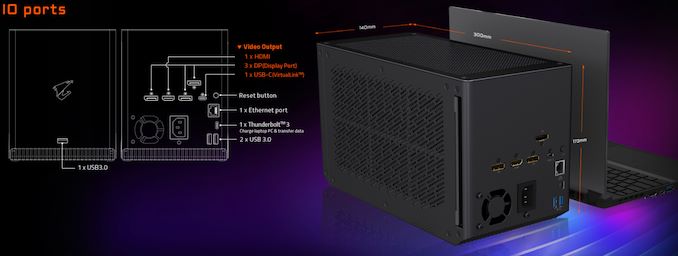


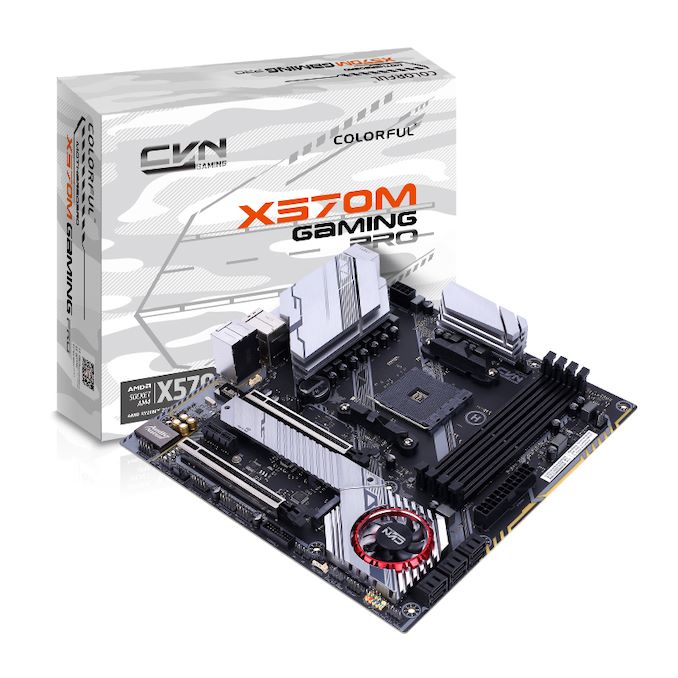
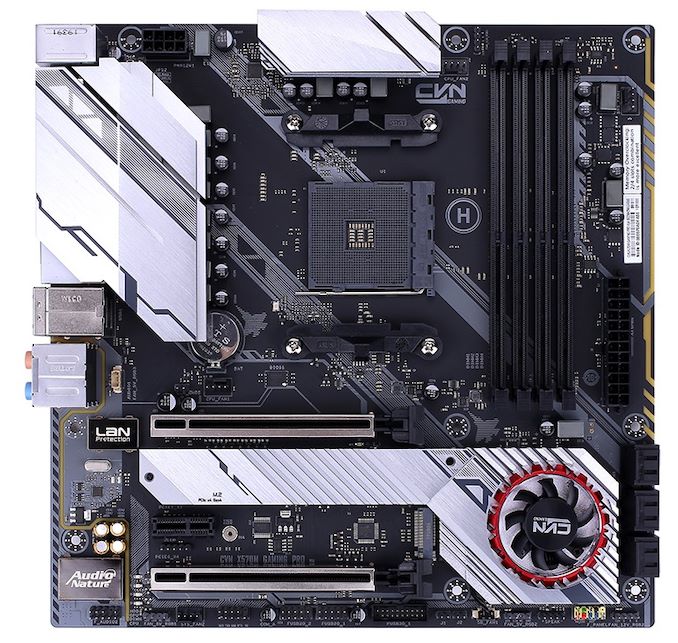

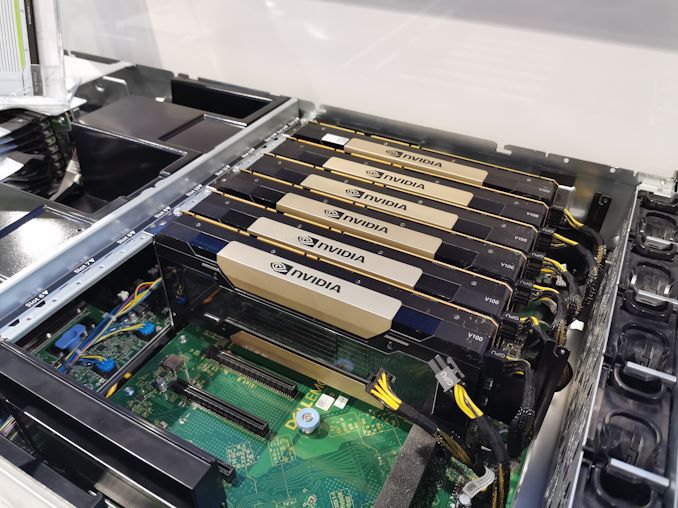
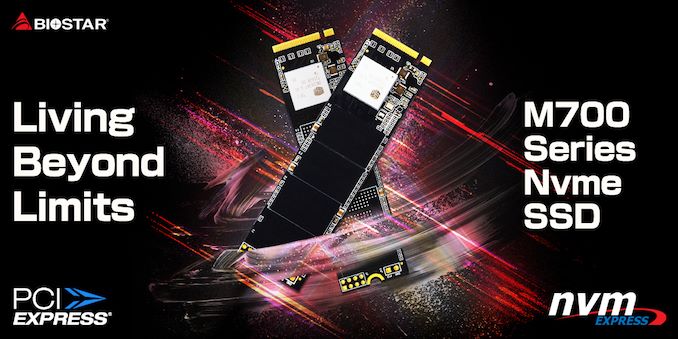

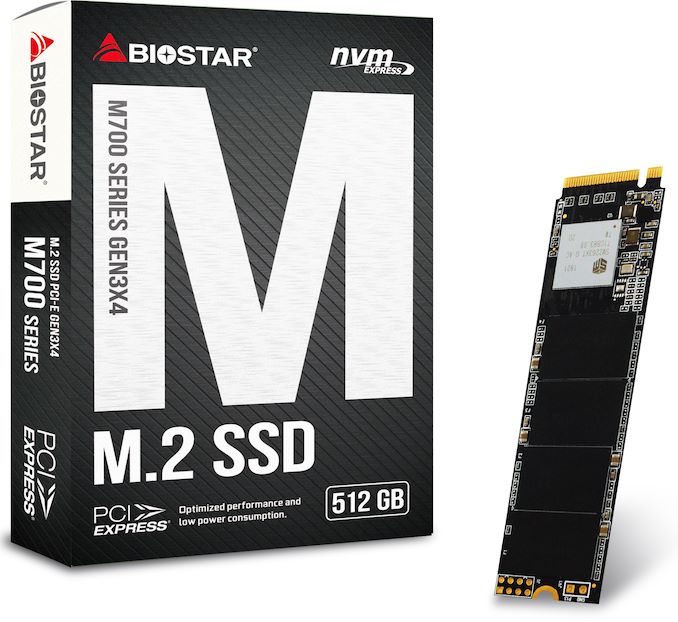
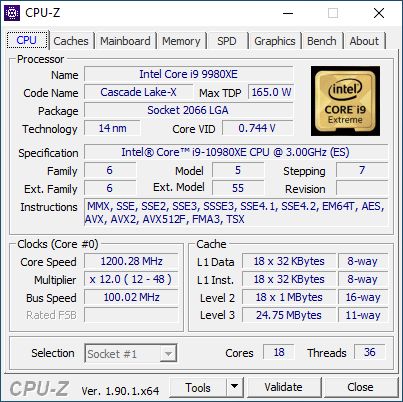
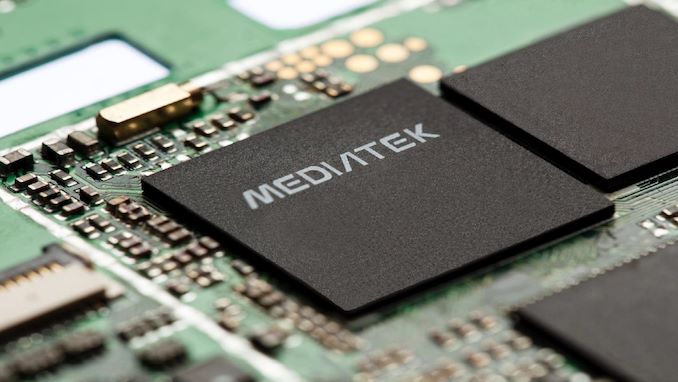
















Bookmarks